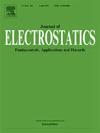Effect of contaminant particles, temperature, and humidity on the dielectric strength of insulating oils
IF 1.9
4区 工程技术
Q3 ENGINEERING, ELECTRICAL & ELECTRONIC
引用次数: 0
Abstract
In this work, the behavior of the dielectric breakdown voltage of insulating oils concerning variations in temperature, humidity, and contaminant concentration was established. Tests used electrodes for flat, spherical, and Verband Deutscher Elektrotechniker (VDE) type. The influence of contaminant concentration (cellulose, iron, and copper), humidity, and temperature on the breakdown voltage of the oils was determined through a four-level experimental design. Data collected in the tests were analyzed using Analysis Of Variance (ANOVA). The experimental phase of the research was carried out in the High Voltage Laboratory of Unidades Tecnológicas de Santander. The most relevant results showed that the contaminant concentration is inversely related to the oil breakdown voltage, with copper being the material with the most significant influence on the study variable. Likewise, temperature is directly related to the breakdown voltage level, with the highest levels reached when the test is conducted at 90 °C. For the three types of electrodes used, it is shown that humidity has an inverse relationship with breakdown voltage. In all cases, the highest disruption values are achieved with a moisture of 5 ppm.
污染颗粒、温度和湿度对绝缘油介电强度的影响
在这项工作中,建立了绝缘油的介电击穿电压随温度、湿度和污染物浓度变化的行为。测试使用的电极为平面型、球形型和通用Deutscher electrotechniker (VDE)型。通过四水平实验设计确定了污染物浓度(纤维素、铁和铜)、湿度和温度对油击穿电压的影响。使用方差分析(ANOVA)对试验中收集的数据进行分析。该研究的实验阶段是在Unidades Tecnológicas de Santander高压实验室进行的。最相关的结果表明,污染物浓度与油击穿电压呈负相关,其中铜是对研究变量影响最显著的物质。同样,温度与击穿电压水平直接相关,在90°C下进行测试时达到最高水平。对于所使用的三种类型的电极,湿度与击穿电压呈反比关系。在所有情况下,最高的破坏值是在水分为5ppm时实现的。
本文章由计算机程序翻译,如有差异,请以英文原文为准。
求助全文
约1分钟内获得全文
求助全文
来源期刊

Journal of Electrostatics
工程技术-工程:电子与电气
CiteScore
4.00
自引率
11.10%
发文量
81
审稿时长
49 days
期刊介绍:
The Journal of Electrostatics is the leading forum for publishing research findings that advance knowledge in the field of electrostatics. We invite submissions in the following areas:
Electrostatic charge separation processes.
Electrostatic manipulation of particles, droplets, and biological cells.
Electrostatically driven or controlled fluid flow.
Electrostatics in the gas phase.
 求助内容:
求助内容: 应助结果提醒方式:
应助结果提醒方式:


